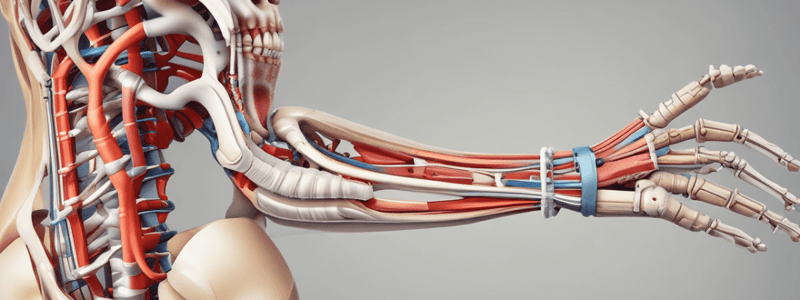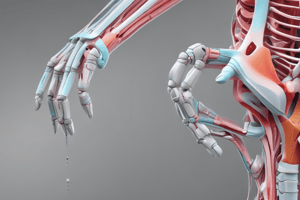Podcast
Questions and Answers
Arthrology is the study of muscles and their functions.
Arthrology is the study of muscles and their functions.
False (B)
Understanding impairments of joints is not important in kinesiology.
Understanding impairments of joints is not important in kinesiology.
False (B)
The design of a joint depends solely on the components and not on its function.
The design of a joint depends solely on the components and not on its function.
False (B)
Joints designed for stability are different from joints designed for mobility.
Joints designed for stability are different from joints designed for mobility.
Design complexity increases as functional demands decrease.
Design complexity increases as functional demands decrease.
Synarthroses allow for a wide range of movement between bones.
Synarthroses allow for a wide range of movement between bones.
Arthrokinematics and osteokinematics are among the objectives of studying arthrology.
Arthrokinematics and osteokinematics are among the objectives of studying arthrology.
Classification of joints based on movement potential is not relevant in arthrology.
Classification of joints based on movement potential is not relevant in arthrology.
Passive ROM involves maximum force by the extensors in middle range.
Passive ROM involves maximum force by the extensors in middle range.
Degrees of freedom refer to the number of independent movements allowed at a joint.
Degrees of freedom refer to the number of independent movements allowed at a joint.
Impure swing in osteokinematics involves pure back and forth movement around a fix pivot point in one plane.
Impure swing in osteokinematics involves pure back and forth movement around a fix pivot point in one plane.
The physiological barrier marks the end of the outer range of motion.
The physiological barrier marks the end of the outer range of motion.
Joint play refers to the externally forced movement of one articular surface over another.
Joint play refers to the externally forced movement of one articular surface over another.
Active ROM involves maximum force by the extensors in inner range.
Active ROM involves maximum force by the extensors in inner range.
End feel is the underpressure experienced at the end of passive ROM.
End feel is the underpressure experienced at the end of passive ROM.
Spin in osteokinematics involves rotation around a joint axis.
Spin in osteokinematics involves rotation around a joint axis.
Connective tissues have the inherent ability to tolerate loads.
Connective tissues have the inherent ability to tolerate loads.
Stress is defined as the force applied per unit area.
Stress is defined as the force applied per unit area.
Strain refers to the change in shape, length, or width of a structure.
Strain refers to the change in shape, length, or width of a structure.
The stress-strain curve has only one zone.
The stress-strain curve has only one zone.
In the elastic or linear zone, the tissue returns to its original length or shape, and most of the energy used to deform the tissue is released once the deforming force is removed.
In the elastic or linear zone, the tissue returns to its original length or shape, and most of the energy used to deform the tissue is released once the deforming force is removed.
The load applied to a structure or material is always an external force.
The load applied to a structure or material is always an external force.
The type of stress and strain that develops in human structures is independent of the nature of the material, type, direction, magnitude and rate and duration of the load that is applied, and the point of application of the load.
The type of stress and strain that develops in human structures is independent of the nature of the material, type, direction, magnitude and rate and duration of the load that is applied, and the point of application of the load.
The stress-strain curve shown in the figure represents the tension generated by an excised ligament that has been stretched to a point of mechanical failure.
The stress-strain curve shown in the figure represents the tension generated by an excised ligament that has been stretched to a point of mechanical failure.
The articular surface of one bone in an ovoid joint is convex, and the other is concave.
The articular surface of one bone in an ovoid joint is convex, and the other is concave.
In a saddle joint, both bones have paired convex and concave surfaces oriented at a 45° angle to each other.
In a saddle joint, both bones have paired convex and concave surfaces oriented at a 45° angle to each other.
Synovial fluid helps reduce friction in diarthrodial/synovial joints.
Synovial fluid helps reduce friction in diarthrodial/synovial joints.
Articular cartilage covers the bones in diarthrodial/synovial joints.
Articular cartilage covers the bones in diarthrodial/synovial joints.
Intraarticular discs or menisci are always present in diarthrodial/synovial joints.
Intraarticular discs or menisci are always present in diarthrodial/synovial joints.
Osteokinematics describes the motion between the articular surfaces of joints.
Osteokinematics describes the motion between the articular surfaces of joints.
Compression is an example of an axial translatory force in joint kinetics.
Compression is an example of an axial translatory force in joint kinetics.
Joint play is necessary for the articular surfaces to slide in the desired direction of bone movement.
Joint play is necessary for the articular surfaces to slide in the desired direction of bone movement.
Tissues that are elongated beyond their physiologic range eventually reach their yield point.
Tissues that are elongated beyond their physiologic range eventually reach their yield point.
Plastic deformation of a tissue is recoverable when the deforming force is removed.
Plastic deformation of a tissue is recoverable when the deforming force is removed.
The anterior cruciate ligament is normally strained about 3-4% during common activities.
The anterior cruciate ligament is normally strained about 3-4% during common activities.
Most healthy tendons fail at about 8-13% beyond their prestretched length.
Most healthy tendons fail at about 8-13% beyond their prestretched length.
Plasticity is the physical behavior of an overstretched or overcompressed tissue.
Plasticity is the physical behavior of an overstretched or overcompressed tissue.
In the plastic zone, microscopic failure has occurred and the tissue remains permanently deformed.
In the plastic zone, microscopic failure has occurred and the tissue remains permanently deformed.
Increased strain in the plastic zone results in significant increased stress (tension).
Increased strain in the plastic zone results in significant increased stress (tension).
The design of a joint is dependent solely on its function.
The design of a joint is dependent solely on its function.




